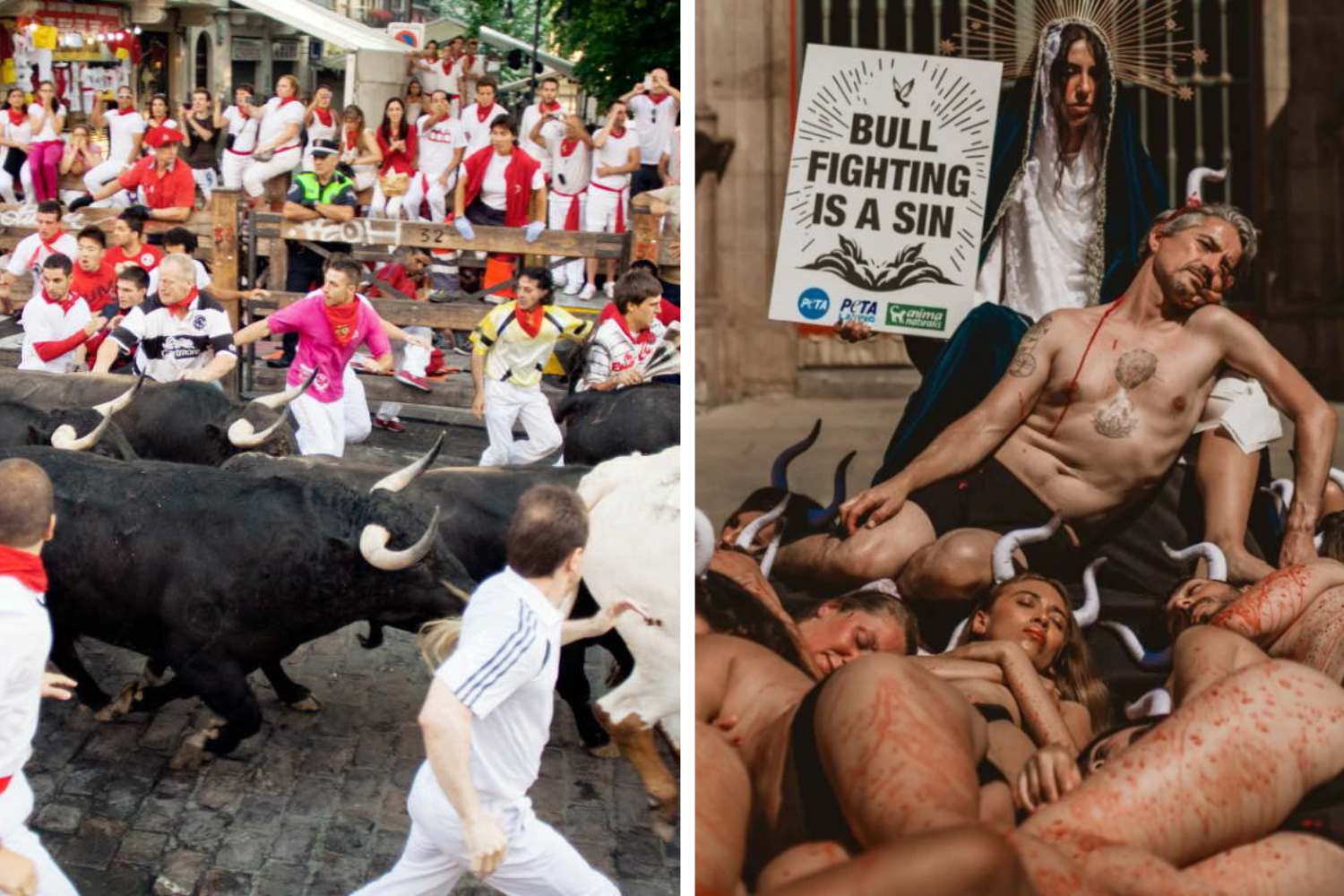San Fermín returns with its controversial bull runs and rising protests. As injuries mount, activists ask: can tradition still justify this violence?

@PETA
Tradition wrapped in adrenaline and cruelty
Here we go again. The San Fermín festival has once more ignited the streets of Pamplona — a riot of celebration, tradition, and, inevitably, controversy. The 850-meter (0.53 mile) bull run, a spectacle as dangerous as it is famous, left six people lightly injured and hospitalized this year. Another round of chaos that, frankly, surprises no one.
But before the bulls charged through the old town, a very different kind of drama unfolded. Activists from PETA and AnimaNaturalis staged a visually arresting protest, aiming to highlight the cruelty of bullfighting. Hundreds gathered to take part in a symbolic action that was equal parts performance art and political statement — one that grabbed the media’s attention for its boldness and raw imagery.
A sacred image turned protest symbol
At the center of the scene stood a woman dressed as the Virgin Mary, cradling a statue of Jesus Christ, surrounded by naked activists drenched in fake blood. According to Aida Gascón, director of AnimaNaturalis, the visual was designed to represent the “souls” of the bulls killed during the bullfights each year.
“It’s true that our fight is progressing very slowly,” said Gascón, “but we’re starting to see signs of change — like the initiative taken by the mayor of Pamplona, who this year organized a public consultation asking residents what they really think about the San Fermín festivities, including the bullfights and the bull runs. It will be very interesting to hear what the people of Pamplona have to say.”
That simple idea — asking locals how they feel about a long-standing tradition — carries weight. Especially when it’s a tradition built on blood and spectacle.
Behind the fiesta: death in plain sight
Ernest Hemingway may have immortalized San Fermín in his novel The Sun Also Rises, but the real story behind the festival isn’t quite so romantic. Every morning, as crowds of runners try to stay ahead of the bulls, a darker truth lurks behind the thrill: none of the animals survive. After the run, they’re herded into the arena, where they’re killed in the evening bullfights.
Primo encierro a Pamplona (Spagna) in occasione dei Festeggiamenti in onore di San Fermin 2025.Lo Staff
Posted by Associazione Culturale Tradizione Di Fuoco on Monday, July 7, 2025
From July 7 to 14, more than one million people flood the streets of Pamplona to take part in the celebration. The “encierro”, or morning run, is the most iconic event — and also the most dangerous. Every year, dozens of people are injured. In some cases, people die. This year’s six injuries are unlikely to be the last.
But it’s not just the human toll that concerns critics. Activists argue that the time has come to rethink the ethical cost of this spectacle, especially in a society that claims to value life and dignity.
The slow unraveling of a spectacle
Despite its global fame and huge tourism appeal, bullfighting is losing support, particularly among younger generations. After the pause forced by the COVID-19 pandemic, some hoped the bullfights would be permanently removed from the festivities. That didn’t happen. But the conversation is shifting.
More and more Spaniards — and not just activists — see bullfighting as outdated, a practice that no longer aligns with modern values or respect for animals.
In 2025, we have to ask ourselves: can tradition still justify this kind of violence? Or are we simply clinging to the past out of habit and fear of change?
The future of san fermín: courage or stagnation?
San Fermín doesn’t have to disappear — but it could evolve. The city could celebrate its history, culture, and community in a way that doesn’t involve death in the streets. It’s not an impossible ask. It just requires a shift in focus — from spectacle to substance, from cruelty to connection.
“Continuing to celebrate these practices in the name of history,” Gascón warned, “risks becoming a form of moral blindness.”
Traditions aren’t sacred by default. They’re choices we make — or remake — every day. The San Fermín festival could be reimagined as something more inclusive, more compassionate, more alive. But to get there, it will take more than slogans or protests.
It will take a collective decision — and the courage to put life, dignity, and empathy at the center of celebration.
‘Virgin Mary’ is making a bloody plea at the #SanFermín Running of the Bulls — never attend a bullfight! pic.twitter.com/yF5dIBWzqe
— PETA (@peta) July 5, 2025
